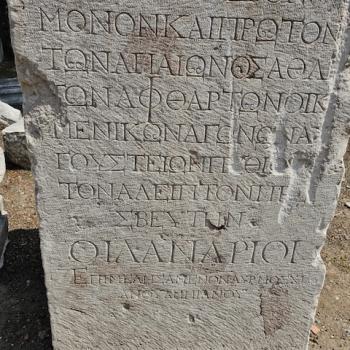There is a new book out on the market comparing and contrasting four popular recent translations Evangelicals tend to use— the NIV, the NLT, the ESV, and the HCSB. The book is entitled Which Bible Translation Should I Use? A Comparison of Four Recent Versions, and its introducers and editors are Andrew Kostenberger and David Croteau (B+H, 2012, 204 actual pages). Each of the four versions are essentially presented or defended by four individuals who were involved in the translation work themselves— ESV (Wayne Grudem), NIV (Doug Moo), HCSB (Ray Clendenen), and NLT (Philip Comfort). In this particular post I want to address only one issue, that of literalism.
Let it be noted first that none of these four translations really deserve to be called ‘literal’ translations in the strict sense. They are not. They do not follow, for example the word order of the Hebrew or Greek sentences again and again and again for the sake of making good sense in English. In other words, comprehension trumps literalism. Sometimes you will hear one or another of the defenders of the ESV or HCSB or the NKJV claim that their translation is ‘essentially literal’ but not ‘woodenly literal’ (with the latter meaning following word for word the word order in the original language).
But in fact, to the degree that a translation like the ESV is dependent upon or even a return to more nearly following the verbage of the KJV, it is not even ‘essentially literal’ (and this critique would apply to the NKJV even more). Why not? Because the King James was not a literal translation in the first place! To the contrary, it incorporates numerous of the wonderful idiomatic expressions that William Tyndale used to translate the original languages— expressions like ‘the skin of one’s teeth’ or the like.
The KJV was never intended to be an entirely from scratch translation in any case, for Lancelot Andrewes and his team were quite specifically told to follow a couple of important previous English versions, and they did so, relying heavily on Tyndale who was really good at coining idiomatic phrases. This is a story for another day, and it is ably told by Alistair McGrath in his wonderful book In the Beginning: The Story of the King James Bible (2002) which I reviewed a long while back on this blog when it was at Beliefnet. McGrath’s book should be required reading for all KJV and NKJV and also ESV advocates.
One of the things Wayne Grudem regularly complains about when it comes to the NIV and other translations is that they try to be a bit more gender inclusive or gender neutral in their rendering of the text at various points, and so we are losing male words and male pronouns, when those words can perfectly well be used in inclusive senses when the audience involves both males and females.
For example, in his discussion of the term adelphos in the Bible Translation book he stresses that the singular form of the word always and everywhere in the NT and LXX (some 428 times) refers to a male, where as the plural can refer to a mixed audience of men and women.
The problem with this conclusion is that there are other words, which are used in the singular, which are masculine gender words which in fact refer to a woman! For example, take the reference to Phoebe in Romans 16.1 who is called both ‘our sister’ (adelphen) and a deacon (diakonov). Not a female form of the word deacon, but rather the male form. So, apparently Paul does not have a problem with using a masculine noun in the singular of a woman any more than he has a problem with using a plural masculine noun like ‘brothers’ of both ‘brothers and sisters’.
Now, if the goal is pure literalism, then Phoebe should be called a ‘deacon’ however odd that may roll off the tongue of some. But there is in fact a problem with literalism especially when it comes to language being used in spiritual or figurative senses in the first place by which I mean the use of the terms ‘brothers and sisters’ of Christians not to refer to physical kinship, but rather Christian kinship in the family of faith.
Let’s return for the moment to the discussion of why some translators go for ‘essential literalism’ rather than ‘wooden literalism’. The answer is surely comprehension. And it is for that very same reason that an ‘essentially literal’ translation is often not to be preferred when it comes to the use of exclusively or almost exclusively male nouns and pronouns. Why not? Because it may it fact make comprehension less likely in today’s world! When the audience of an address is both men and women, as made clear or highly probable from the context, the translation ‘men’ or just ‘brothers’ does a disservice to a significant portion of the audience, namely the women. For the sake of comprehension and clarity and even gender distinction, the translation ‘brothers and sisters’ is far better and more accurate and true to the context than just ‘brothers’ or ‘men’.
Let me illustrate by referring you to a book I am currently working on a review of by Paul Trebilco entitled Self-designations and Group Identity in the New Testament, (Cambridge, 2012). In his chapter on “Brothers and Sisters’ (pp. 16-66) Trebilco points out the following: 1) overwhelmingly in the NT, the term brothers is used metaphorically or figurative to refer to Christians who are considered members of the family of faith (following Jesus’ definition of family in a text like Mk. 3.31-35 and par.) This is the case an amazing 271 times in the NT and in all of its books except Titus and Jude.
In other words, only in a minority of cases is the term ‘brothers’ used in a strictly original literal sense to refer to physical kin! 2) more often than not in the Pauline corpus, the term ‘brothers’ is used inclusively to refer to both Christian men and women as is made clear by the immediate context. Take for example Phil. 4.1-2— Paul urges the adelphoi to get along, and then he singles out two women leaders, two co-workers as specific examples of such adelphoi who need to get along. I will let you examine the evidence in pp. 24ff. but suffice it to say that it is easy to show that in Paul and in Acts such metaphorical language is used inclusively. See for example 2 Tim. 4.21 where Paul sends greetings from the ‘brothers’ and one of them is said to be Claudia! But of course, she’s a sister, just like Phoebe, and in our context it’s not appropriate to call a sister ‘a brother’.
One of the things I find most strange about the arguments of folks like Wayne Grudem is of course they are complimentarians, not egalitarians, which is to say they want to specifically stress the differences between men and women and not talk in ways that suggest gender neutrality, or the like. And yet, in translations they want to talk as if all persons being addressed are males even when the context indicates gender inclusivity! This is very odd for someone who is a big advocate for preserving, respecting, and honoring the essential gender differences between men and women and honoring Biblical womanhood.
You would think we would have more places translating adelphoi as ‘men and women’ where the context indicates it, not less. In other words, the insistence on a literal translation not only does not promote better comprehension of who is involved in such a verse as 2 Tim. 4.21, it also fails to promote the desire to preserve and honor gender distinctions as well when both men and women are clearly involved in a text. Strange.
The question is— In a Biblically illiterate age and in a culture which is far less patriarchal than Biblical culture, is it more or less helpful towards the goal of comprehensive to translate verses where men and women are both involved with gender exclusive language or gender inclusive language? Which is more likely to promote understanding of the actual meaning and reference of the text? Here the answer seems clear, especially when metaphorical or figurative language is being used anyway!
And let me point to another oddity about this. Take an example like Paul’s quotation of 2 Sam. 7.14 in 2 Cor. 6.18. Here Paul is in all likelihood following the LXX. What is extremely interesting is the LXX only has the singular term ‘sons’ at this juncture, but Paul adds ‘and daughters’ to make clear the inclusive reference that seemed apparent to him from the context of 2 Sam. 7.14. Here then, we have Paul himself providing a precedent for using a clarifying more gender inclusive phrase even when the original text has only ‘sons’!!
The real question is whether the decision in the ESV to go back to using more male pronouns and nouns, even in some places where gender inclusivity seems obvious from the context has more to do with an attempt to repristinize patriarchy than an attempt to be faithfully ‘literal’ and so ‘more like the KJV’. I’m afraid that the former really is often the agenda when it comes to the ESV. And I find this both unhelpful and profoundly sad.
Contra Grudem, it is simply incorrect to say “you never use a masculine singular noun to mean a ‘male or female person’” (p. 60 of the Bible Translation book). Really? Actually, sometimes the writers of the NT do. In a highly patriarchal culture like the writers of the NT lived in, it is not at all a surprise that masculine language dominates even when it comes to figurative language applied to the Christian community. The surprise is, that there is evidence of other sorts of uses at all! And there is a reason for these ‘other sorts of uses’.
Both Jesus and Paul were in fact all about more gender inclusivity when it came to discipleship, and roles within their communities. Paul was pretty clear that in Christ ‘there is no male and female’ for all are one (Gal. 3.28) and he believed such a pronouncement had social implications about roles and functions. That’s why in Romans 16 we not only hear about a woman ‘deacon’ we even likely hear about a woman apostle named Junia (Rom. 16.7) who was a fellow Jewish Christian and co-worker with Paul along with her husband Andronicus (see Eldon Epp’s book entitled Junia). But that is a conversation for another day.













